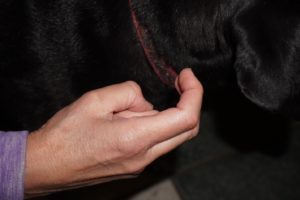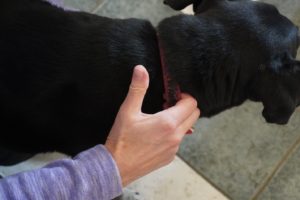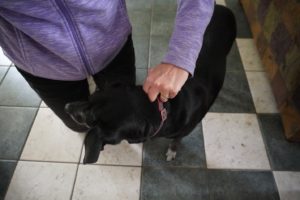This hold controls direction in 6 ways to reduce movement and provide staff safety from head flip or bite attempts. This technique is part of the HMR Lab 3 of the Low Stress Handling® Certification Course – Silver.
The handler places forward pressure if the dog moves back; downward pressure if the dog moves up; upward if the dog moves down; and laterally in opposite to the dog’s movement. Combine this technique with targeting to help the dog focus and learn to stand in place for blood draw, injection, palpation, and nail trims.
The index and middle finger form a curve that hooks over the top of the collar, behind the base of the ear. You may hold with your thumb from underneath as well to avoid slipping around the collar. Replace any choke, or prong, collars with a flat nylon buckle collar that is at least 1 ½” wide for comfort.
Correct hand/finger placement – side of the neck near the base of the ear.
INCORRECT HAND HOOK- This placement is where many dogs have been collar corrected. They may head flip from past pain memory if you hook here. Also, you cannot control the movement of the head with your hand hooked at the middle of the neck. The hook at the side provides the lateral movement control which is very important to reduce head flip or bite risk.
Target to food with hold method – as my hand is against the base of the dog’s ear, she cannot flip her head around to bite. She can focus on the food in my hand or a target item.
You can use the collar hold on harnesses, as seen with this puppy. The technician from Zionsville Country Veterinary Clinic in Zionsville, Indiana, uses this hold to limit the puppy’s movement as she prepares treats for vaccination and exam.
The collar hold on a timid puppy, first exam. The technician has control of movement without force as the puppy receives a reward.
See our Youtube video on blood draw using the collar hold with targeting








